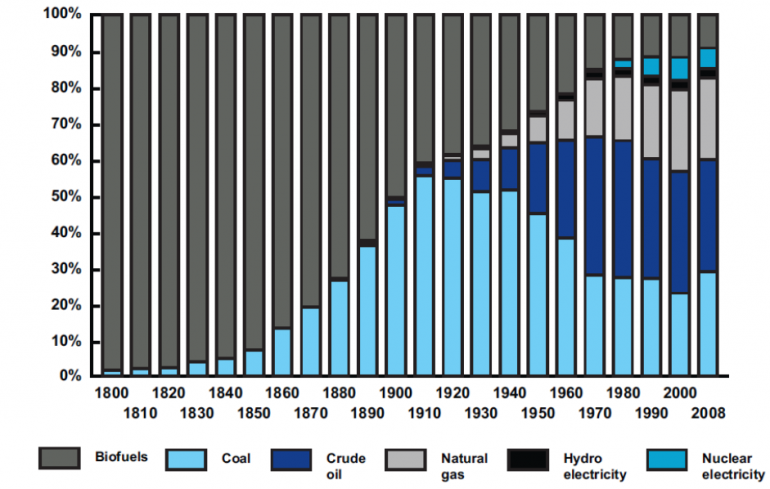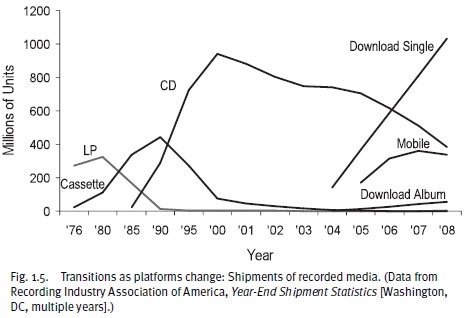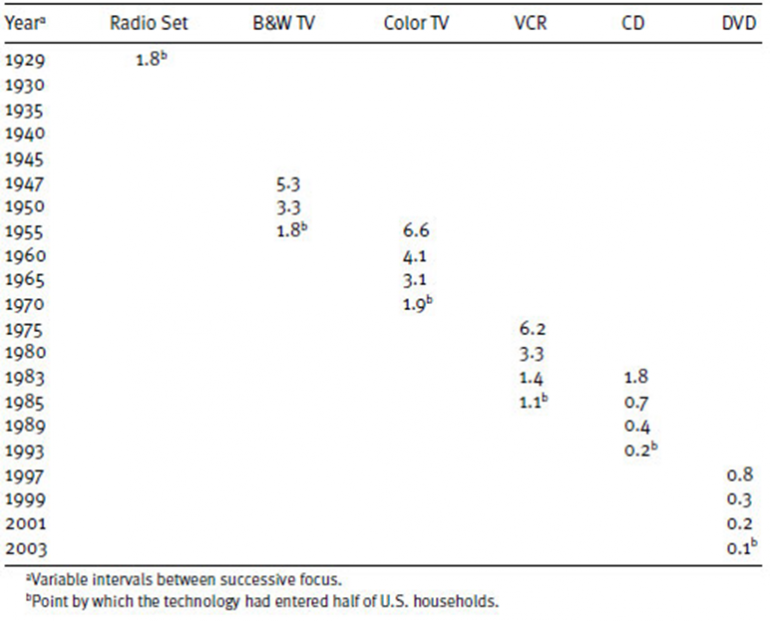Can solar emulate Apple's computer revolution?
Tuesday’s article Solar’s 100GW king-hit, showed that one credible forecaster foresees growth of solar PV installations that appear so rapid as to be unbelievable – by the end of this decade solar would stand head and shoulders above all other fuels sources in terms of additions of new global power generating capacity.
If history is any guide, transitioning from one energy source to another is an extremely slow process, as illustrated by the chart below. Given this history, it is believed that decarbonising our energy supply will take many, many decades and be incredibly difficult. So are there reasons why solar could buck the trend?
Global market share of different energy fuel types since 1800

Source: Vaclav Smil (2010) Energy Transitions: History, Requirements, Prospects
Looking to the past, from 1800 (40 years after James Watt, as in the watt that goes into a kilowatt, patented his steam engine) it took a century for coal to displace wood as the dominant source of energy. Oil had a faster rise of about 70 years. Nuclear made a good start (light blue) but quickly flatlined and is now in decline.
Transitioning from one fuel to another takes decades because it typically requires all new infrastructure, new skills, new knowledge and new machines. This all costs lots of money and takes lots of time to build up.
Probably, most important of all these factors is the embedded, highly capital intensive infrastructure. Coal requires not just mines but railways, barge canals and large ships. Oil also initially required railways, and then pipelines, plus refineries, mega tankers and also roads (to take the cars that consumed the oil). Gas also requires processing plants and pipelines. And to be employed to generate electricity they required further billions of dollars in investment, rolling out grid infrastructure to connect up homes and businesses.
But what if a solar system is more like an electronic appliance – like a television or a computer or an air conditioner – rather than a coal power station or an oil refinery?
Electronic appliances are plug and play, connecting seamlessly into existing electricity infrastructure with minimal new skills required. The speed of market adoption of new electronic appliances towards a majority of the market, and shifts from one technology platform to another, can happen within a decade. In fact, the speed of market saturation has become faster in some categories of consumer devices over time.
As an example, the chart below shows the speed of transition between different music playback technology platforms. Tape cassettes passed LPs within around five years and fully supplanted LPs within about 15. CDs soared past cassettes within a similar time period. Music downloads from the web surpassed CDs in the space of three years.
Shipments of music media by technology platform

Source: Carey and Elton (2010) When Media Are New: Understanding the Dynamics of New Media Adoption and Use
There are countless other examples available in consumer electronics showing similar short time frames to market saturation. Personal computers took around 17 years to penetrate 50 per cent of American households, VCRs took 10 years and DVDs took just six. Plasma screen televisions soared past cathode ray TVs and then were very quickly supplanted by LCDs, all within a few years.
Then there are some other examples that are slow to begin with but then suddenly surge. Air-conditioners were slow to penetrate the Australian household market initially, installed in only about 20 per cent of households by around the mid 1990s. But then, with the advent of split-system reverse-cycle systems, they were in about 70 per cent of households within a decade. Laptop computers are another example, they were widely commercially available for about a decade before then rapidly taking over from desktops.
Pivotal to these rapid transformations are rapid reductions in the price of equipment. As the table below illustrates, the number of weeks of income required to purchase these items of equipment plunges rapidly.
Average price of selected electronic products in weekly household income for the US

Source: Carey and Elton (2010) When Media Are New: Understanding the Dynamics of New Media Adoption and Use
Now, there is a big difference in the affordability of a CD and DVD player at the beginning of their lifetime and a solar system today. But the current price of a 2 kilowatt solar system is not all that far off the levels of TVs or VCRs at the beginning of their mass uptake. Laptop computers also used to cost several thousand dollars, just like solar systems.
The way in which solar systems are manufactured and rolled out are closer in similarity to consumer electronics and computing, than the oil and gas industry or coal-fired power stations. They are a factory mass-produced, solid state piece of electronics which don’t require any particularly challenging skill-sets to install. With the rollout of reliable micro-inverters, such as those available from Enphase, installation becomes even easier. And they piggyback off existing electricity infrastructure rather than requiring brand new infrastructure.
Of course, this is not to suggest that it is a certainty that solar will follow the same market penetration growth path as laptop computers. Also, even the growth outlined in Tuesday’s article would still mean it would be decades before solar’s share of energy supply got close to coal. But there are good reasons to question the idea that solar PV must be plagued by the same time lags to mass adoption encountered by other energy sources.













